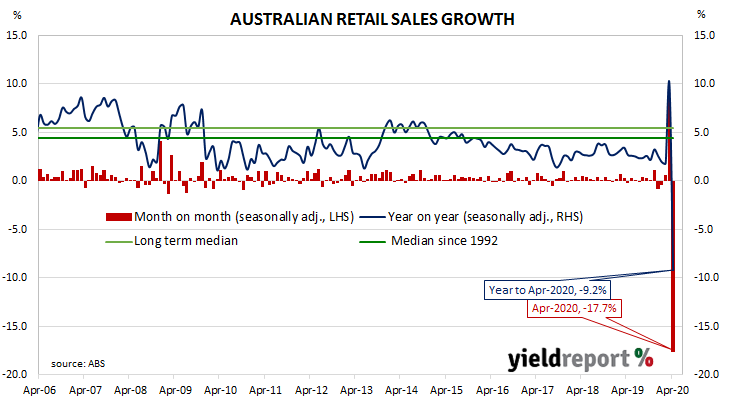Summary: Retail sales slump in April, reversing March’s spike; spending on food drops back below pre-stockpiling level; economists expect better May.
Growth figures of domestic retail sales have been declining since 2014 and they reached a low-point in September 2017 when they registered an annual growth rate of just 1.5%. They then began increasing for about a year, only to stabilise at around 3.0% to 3.5% through late 2018 before trending lower through 2019 and early 2020. March’s figures bucked the trend as households stocked up; April’s numbers totally reversed that.
According to the latest ABS figures, total retail sales dropped by 17.7% in April on a seasonally-adjusted basis. The fall was basically in line with the 18% decrease which had been expected after “flash” figures were released on 20 May but it also more than reversed March’s +8.5%. On an annual basis, retail sales decreased by 9.2%, as compared to March’s comparable figure of 10.1%.
Retail sales have only fallen by more than 2.4% twice since records began in 1982; first in July 2000 due to the introduction of GST and then in April 2020 due to COVID-19 lockdowns,” noted ANZ economist Adelaide Timbrell.

Longer-term Commonwealth bond yields moved higher, largely in line with US Treasury bond movements. By the end of the day, the 3-year ACGB yield remained unchanged at 0.28% while the 10-year yield had gained 6bps to 1.01% and the 20-year yield had increased by 5bps to 1.66%.
In the cash futures market, expectations of a rate cut were largely unchanged. By the end of the day, July contracts implied a rate cut down to zero as a 54% chance, unchanged from the previous day. August contracts implied a 46% chance of such a move in that month, down from 48%. Contract prices of months in the remainder of 2020 and through to the latter part of 2021 implied similar probabilities, ranging between 35% and 47%.
“April undoubtedly marks the worst of the direct impacts from the Coronavirus lockdown, presuming we do not see another flare up in the virus locally,” said Westpac senior economist Matthew Hassan.

